Use feed management protocols that account for site-specific growth and survival rates
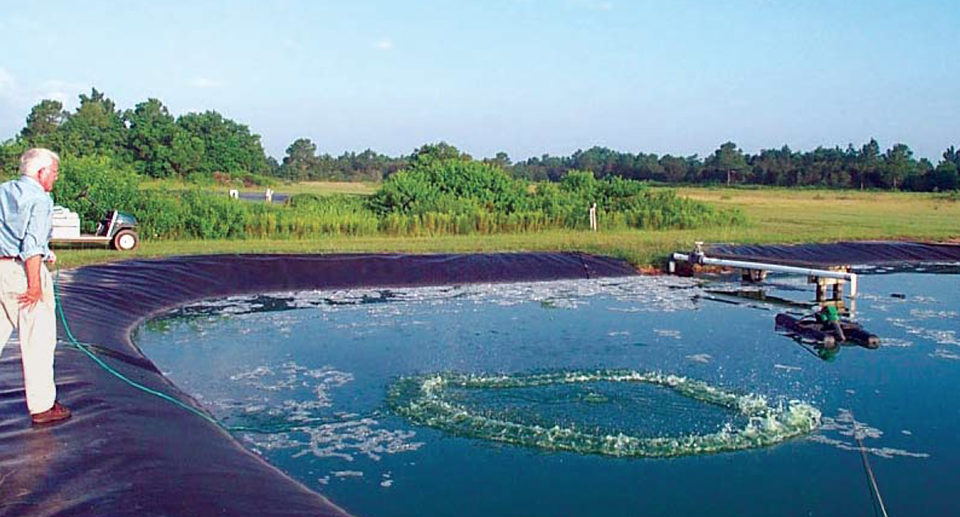
Modern shrimp feeds are generally nutritionally adequate and provide essential nutrients in the proportions necessary for good performance. However, good performance is only obtained if the feed is properly applied and environmental conditions are favorable for good growth and survival.
Nutrient requirements
When selecting a feed and applying it to a production system, one must understand that feed conversion varies with the nutrient density of the diet and feed inputs must be adjusted accordingly. If higher concentrations of a nutrient are in the feed, we would offer less feed.
For example, a well-balanced diet containing 40 percent protein and fed at 75 percent of the ration delivers the same protein as a diet containing 30 percent protein offered at 100 percent ration. If the lower-protein diet meets the nutritional requirements of the animal under a given set of conditions, increasing protein intake by increasing the daily ration does not lead to better growth, but raises feed-conversion ratios and pollution loading of the system.
Similarly, if one chooses to increase the level of protein in the diet and feed the same quantity, growth does not improve, but the feed conversion stays the same. In this case, the efficiency of protein use decreases and nitrogen waste, a byproduct of protein metabolism, increases. Hence, proper feed inputs are very important.
Feeding study
An example of this concept is provided by the results of a recent experiment the authors conducted in Alabama, USA. Fig. 1 shows the final weights of shrimp reared in outdoor tanks with green water from a production pond and offered a 30 or 40 percent protein diet at 75 and 100 percent ration levels. The feeds were well balanced, with the full ration designed very close to the daily requirement with slightly less volume than the shrimp could consume in a day.
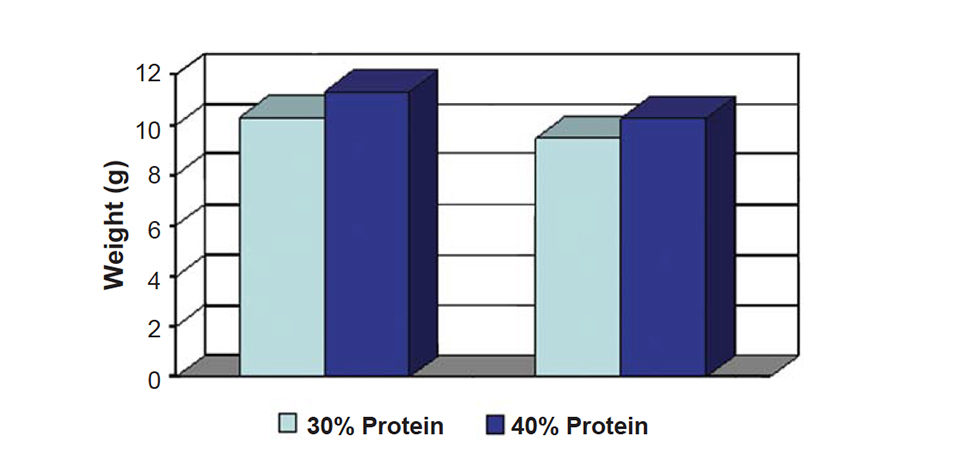
The shrimp reared on the 100 percent ration per 30 percent-protein diet had similar weights to those offered a 75 percent ration using the 40 percent protein diet – 10.33 and 10.28 grams, respectively. These two feed inputs delivered the same amount of protein and hence produced the same amount of growth.
Remember that this only works if one is not overfeeding. As the ration was reduced from 100 to 75 percent, the growth of the shrimp was also reduced. With properly balanced feed, it should take less of a high-protein diet to do the same job. Consequently, the feed conversion should also be reduced.
In the study, feed conversion was 1.41 for the 30 percent-protein diet at 100 percent ration and 1.14 for the shrimp offered the 40 percent protein diet at a 75 percent ration. Hence, properly feeding a nutrient-dense diet can produce better feed conversion and possibly reduce the overall cost of production and water pollution potential.
Understanding feed conversion
Farmers often get poor feed-conversion values because they do not understand what the expected feed conversion should be. Using very general numbers, one can quickly estimate the feed conversion of a given feed by making a few assumptions about nutrient retention.
Assume, for example, that shrimp contain 15 percent protein and that in typical feed, 30 percent of the dietary protein is retained as new tissues that contains about 15 percent protein. If you feed 100 kg of a 30 percent protein diet, the shrimp consume 30 kg of protein (100 kg x 0.30), but retain 9 kg (30 kg protein x 0.30 retention). This would result in 60 kg of shrimp growth (9 kg protein gain per 0.15 protein in shrimp). The feed conversion would be 100:60 (1.7:1) for a 30 percent protein diet, or 100:80 (1.25:1) for a 40 percent protein diet.
These values are slightly higher than those of the previous example, due to the use of generalized assumptions and the contribution of natural productivity, which can be a significant food source. In either case, the theoretical value is a good guide to provide insight into what the feed conversion should be.
Most people would agree that the majority of producers do not get feed conversions as good as those in the above example. In fact, the authors did not get good feed-conversion values at their research facility. The ponds were typically stocked at 35 shrimp per cubic meter. The shrimp were fed a high-quality 35 percent-protein diet twice a day, and dissolved oxygen levels were maintained above 2.5 ppm using about 10 hp aeration per hectare pond surface.
Under these conditions, feed-conversion values were typically over 2:1. A review of yearly production data, as well as a number of planned experiments, clearly indicated that increasing feed inputs did not improve growth or survival. The feed inputs were even possibly hurting due to deteriorations of water and pond bottom quality. Given that feed is one of the primary costs of production and the initial source of water quality problems, feeding protocols were reevaluated.
Reevaluating feeding strategies
The authors first looked at historical production to see if assumptions for growth rates and survival were reasonable. Secondly, they compared feed inputs to theoretical feed requirements based on weight gain and protein retention over relatively short production periods of two to four weeks.
The 60 to 70 percent survival and 1.2 to 1.4 grams weekly growth were relatively constant and reasonable for semi-intensive conditions. However, feed inputs did not match that of the growth compared to theoretical feed inputs. The shrimp were overfed during most of the stages of production.
Most managers recognize that feed is one of the primary factors influencing growth, and so are more likely to overfeed than underfeed. Additionally, most feeding protocols are quite liberal in terms of feed inputs and assume maximum growth, which is often not obtained at the farm level.
For a 35 percent protein diet, a current feeding chart indicated 10-gram shrimp should be fed 3.7 percent of their body weight. Using the previous assumptions, the authors would offer 2.6 grams of feed in a week for 1.86 grams of weight gain. Unfortunately, the best growth their test animals achieved was around 1.4 grams per week, which required only 1.96 grams of feed. If the chart values were used, 24.6 percent of the offered feed would be wasted.
Adjusting feed rations
Underfeeding can result in reduced growth rates, and overfeeding adversely affects water quality, so it is critical to adjust feeding rates to meet the actual demand of the shrimp. This is easy to say but difficult to do on a commercial farm.
Estimated daily feed requirements depend on accurate determinations of shrimp growth and the size of the population. Even under the best of conditions, population estimates are often inaccurate and difficult to determine. Consequently, it is common to adjust daily feed allocations for a given culture system based on factors such as actual growth rates or weekly weights, morning dissolved-oxygen levels, temperature and quantity of feed remaining on feed trays, as well as past performance of the culture system.
Feed inputs and production
Fig. 2 shows examples of historic records of feed inputs in the research ponds. Although a wide variety of feed inputs were used, growth rates and survival remained relatively constant. For example, in 2000, very different feed input rates were applied during the final weeks of production, yet growth rates and final biomass were not significantly different.
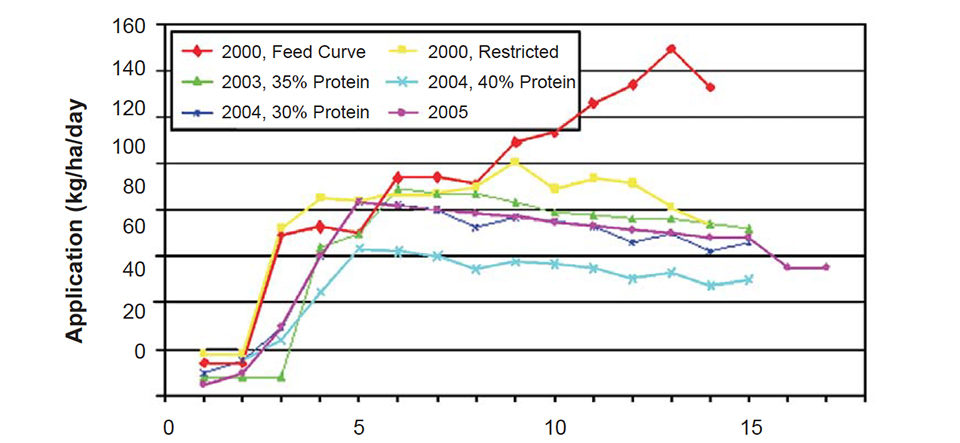
The revised feeding protocols of 2004 and 2005, with lower levels of feed inputs, improved production – presumably by reducing the nutrient loading and improving pond bottom conditions.
In the newer program, feed inputs are initially based on a conservative feed-conversion ratio and historical growth rates. During the first weeks of culture, inputs are increased to meet the needs of the juvenile shrimp. Feed inputs are reduced, however, prior to anticipated problems such as poor dissolved-oxygen levels.
The high-quality feed is delivered twice daily over a large portion of the ponds. The population is initially estimated based on historical results for each week of culture, then adjusted as necessary. Water is not exchanged until the end of the production cycle to reduce the risk of disease introductions and retain the natural productivity in the ponds.
Improving feed utilization
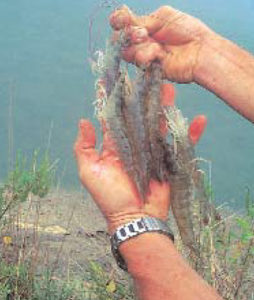
The authors currently target feed conversion rates of 1.2 with a 35 percent protein diet, growth rates of 1.5 grams per week, and 70 percent survival after 16 weeks of pond culture. Given that natural productivity can provide significant contributions to the nutrient intake of L. vannamei, these goals are quite reasonable.
By using a high-quality shrimp feed and revising feeding strategies, they have been able to reduce water quality problems, maintain good growth, and reduce feed inputs that have resulted in significant reductions in feed conversion ratios and hence the investment in feed.
With feed management protocols that account for site-specific growth and survival rates, many commercial producers could improve feed utilization at their facilities. However, they must break the cycle of thinking more feed is better and determine realistic limits for feed inputs.
(Editor’s Note: This article was originally published in the October 2005 print edition of the Global Aquaculture Advocate.)
Now that you've reached the end of the article ...
… please consider supporting GSA’s mission to advance responsible seafood practices through education, advocacy and third-party assurances. The Advocate aims to document the evolution of responsible seafood practices and share the expansive knowledge of our vast network of contributors.
By becoming a Global Seafood Alliance member, you’re ensuring that all of the pre-competitive work we do through member benefits, resources and events can continue. Individual membership costs just $50 a year.
Not a GSA member? Join us.
Authors
-
D. Allen Davis, Ph.D.
Associate Professor, Aquatic Animal Nutrition
Department of Fisheries and Allied Aquacultures
315 Swingle Hall
Auburn University
Auburn, Alabama 36849-5419 USA[117,100,101,46,110,114,117,98,117,97,64,97,100,115,105,118,97,100]
-
J.A. Venero
Department of Fisheries and Allied Aquacultures
315 Swingle Hall
Auburn University
Auburn, Alabama 36849-5419 USA
Tagged With
Related Posts

Aquafeeds
A look at phospholipids in aquafeeds
Phospholipids are the major constituents of cell membranes and are vital to the normal function of every cell and organ. The inclusion of phospholipids in aquafeeds ensures increased growth, better survival and stress resistance, and prevention of skeletal deformities of larval and juvenile stages of fish and shellfish species.
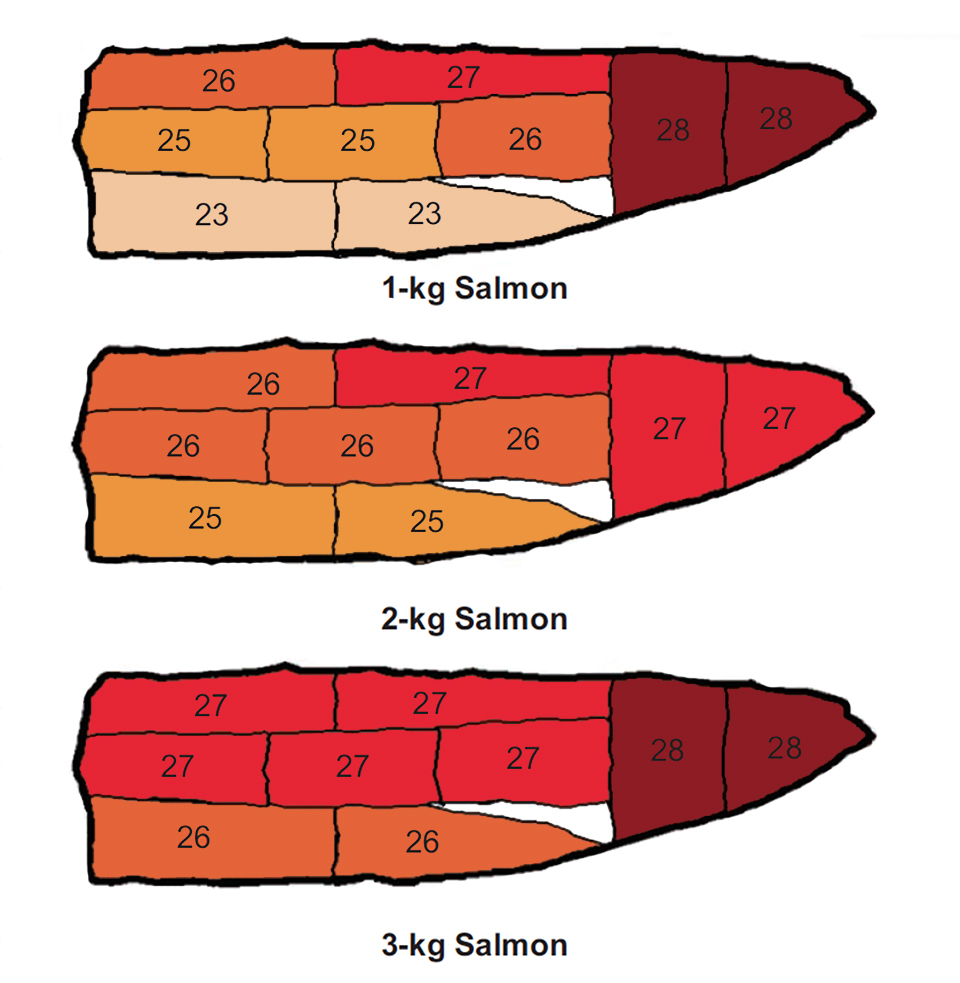
Intelligence
‘Quality map’ for coho salmon fillets identifies color, lipid distribution
In research on coho salmon fillets, muscle astaxanthin level, color, and hardness generally increased from the anterior toward the caudal zone of the fish.
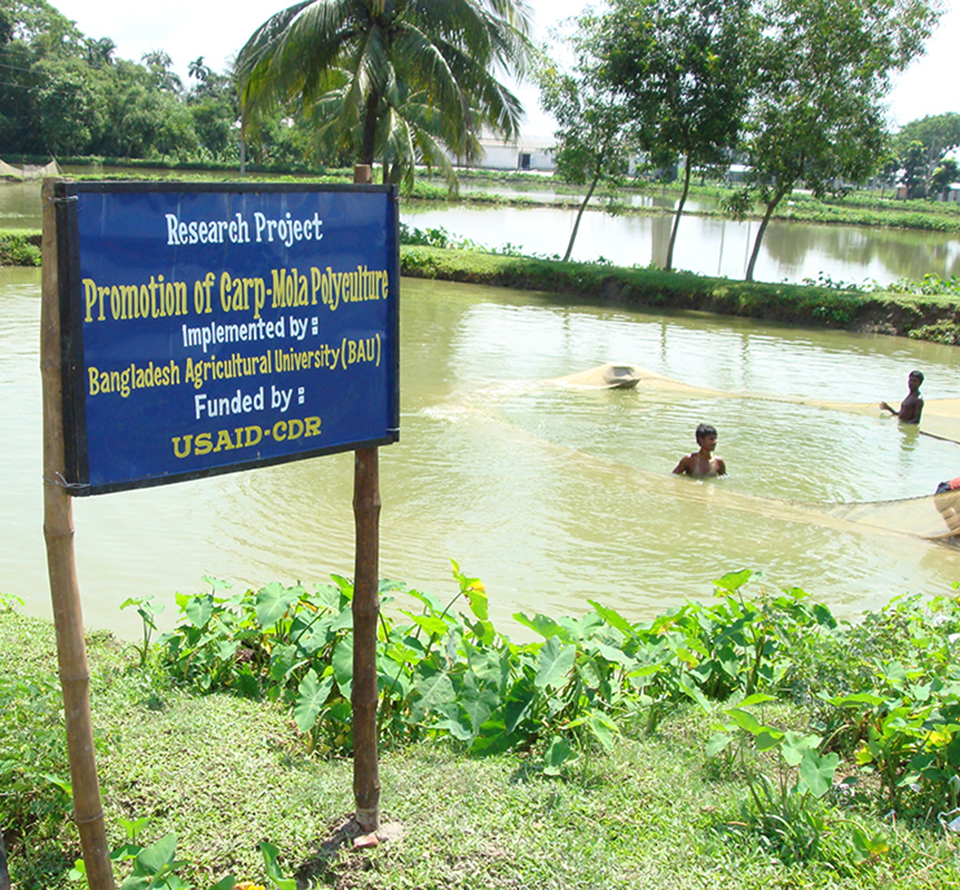
Responsibility
‘Cash-SIS’ culture yields money crop, family food
In a study of pond polyculture, manipulation of species composition improved fish yield and corresponding income. Selling the whole production increased income 27 percent.
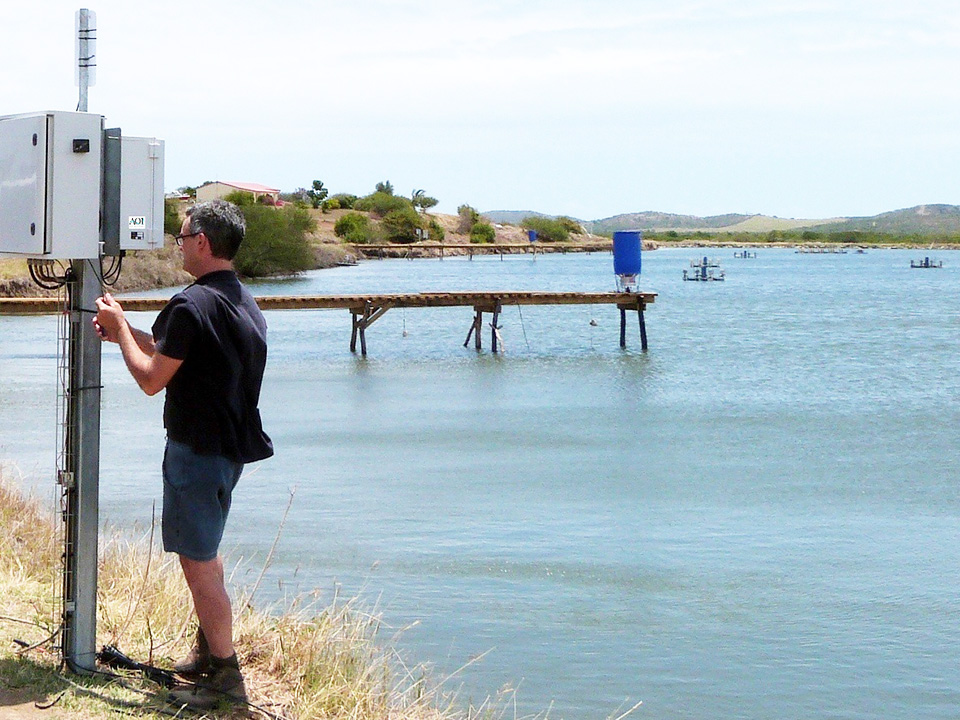
Innovation & Investment
Acoustic control improves feeding productivity at shrimp farms
In systems recently developed for shrimp farms, passive acoustic-based technology enables sensor-based control of multiple automatic feeders. Improved growth and feed conversion have been recorded at commercial farms using the technology.


